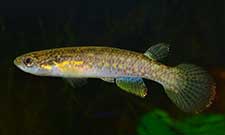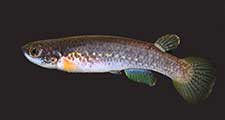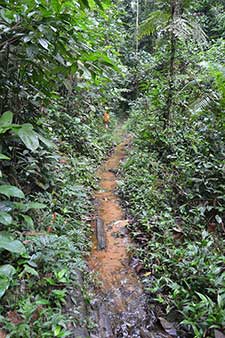History
Abstract: A new species in the family Rivulidae, Rivulus adrianae, is described from a small creek, tributary of the Sipaliwini River, drainage of the Courantyne River in remote Southwestern Suriname. The new species differs from other group members by the bright gold markings on the lateral sides and the absence of the ocellus in males and females. Rivulus adrianae n. sp. also differs by the lack of a longitudinal striped pattern of red spots, typical of most congeners.
Diagnosis: Males of Rivulus adrianae n. spec. differ from all the congeners within the micropus superspecies group by their unique golden markings, starting on the gill cover, continuing below the lateral line, and becoming loosely rows of golden spots posteriorly as far as the caudal basis. A darkened area above, on the gill cover and anteriorly the first quarter of the body, giving the impression of a humeral spot (vs. never a similar color pattern). Rivulus adrianae shares its predorsal length to SL (average 77.4 % vs. average 77.7 %) with most micropus superspecies group members.
Rivulus adrianae, unlike almost all other representatives of the micropus superspecies group, show no spot on the dorsoposterior part of the caudal peduncle in females. Rivulus adrianae differs from R. stagnatus, R. lungi, and R. mazaruni, all known from the Guiana countries i.e. The Cooperative Republic of Guyana, Suriname and French Guiana, by the absence of a white upper and lower margin in the caudal fin and no red lines on the sides, (vs. the presence of white upper and lower margin in the caudal fin, and red dots forming lines on the sides.)
Members of the micropus superspecies group differ from the hartii superspecies group i.e., amphoreus, cajariensis, fransvermeuleni, gaucheri, hartii, holmiae, igneus, immaculatus, mejiai, waimacui, by their smaller overall size; a lower count in dorsal fin rays


Etymology The author dedicates the name of this new species to his wife, Adriana C.M. Vermeulen-Vervenne, co-discoverer of the new species. The author thanks his wife, commonly referred to as Marjan, for her contribution to this discovery, for the 50 years of marriage with the author, for her unfailing support during the author's travels and studies, and for accompanying the author to many women-unfriendly remote places.
INFORMATION: The full publication can be obtained as a hard copy, and as a PDF from Killi Data Online, free of charge for members and for a small fee for non-members. This can be done at the website https://www.killi-data.org Killi-Data Online presents all known top quality information on extant oviparous and viviparous Killies or Cyprinodontiformes, including a data base, with full ichthyological, ecological, behavioral, and historical coverage, and, with aquarium maintenance and breeding information, and, with all details of systematics, morpho-osteology, genetics, patterns for each today valid, synonymous and unavailable taxon. Become a member for free and register at: www.killi-data.org
Reproduction
Keeping and breeding is easy but a tight fitting cover on the aquarium is necessary because their ability to jump, even through the smallest opening, is unbelievable.
This species can, if there is enough space for them, be housed in a tank with more than one male and several females. If separated before and brought together again however, they can be very aggressive towards each other and fight to become the dominant fish. The best way to produce numbers of fry is to put a pair or a trio in a small tank of about 10 litres with a small filter in it or with some aeration. On the bottom of the tank place some peat moss or dark gravel and a floating "mop" to give space for laying their eggs. The fish will, if they are fed a rich variety of live food, spawn during their whole adult life and produce daily between 5 to 15 eggs.
The eggs should be collected by hand and stored for about 14 days in a small container. Eggs are 1.6 mm and amber coloured. It is wise to add an anti fungus to the water you store the eggs in, to prevent fungal attacks.
After hatching the young fry can eat fresh artemia nauplii without any problem. It takes 4 to 5 months to raise them to maturity. Often the males far out number females. For some species this can become a major problem for the breeder, as he has to raise many fry to enable distribution of a few pairs to other hobbyists. Recent personal tests found that lower pH levels during the time of hatching gave a higher percentage of females. To achieve this I used some peat moss that I added to the container with the eggs just before they were ready to hatch. This peat moss also is a good way to prevent eggs from being attacked by fungus.
Their lifespan can be up to 3 years in captivity.
Remarks :
Variations

Map
Meristics
Max. size 49.8 mm (TL)
Dorsal 8.0,
Anal 13-14
LL scale count (average) 36-37
Pre- dorsal length to % SL – 77.4 %
Depth to % SL – 22.4 %
Literature